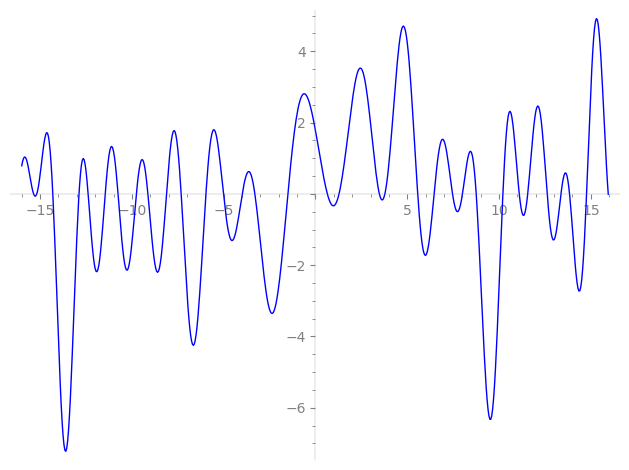| L(s) = 1 | + 5.10i·3-s − 11.1·5-s + 18.5i·7-s + 0.987·9-s + 56.4i·11-s + 93.4·13-s − 57.0i·15-s + 133.·17-s − 94.4·21-s + 125.·25-s + 142. i·27-s − 293.·29-s − 287.·33-s − 207. i·35-s + 476. i·39-s + ⋯ |
| L(s) = 1 | + 0.981i·3-s − 0.999·5-s + 0.999i·7-s + 0.0365·9-s + 1.54i·11-s + 1.99·13-s − 0.981i·15-s + 1.91·17-s − 0.981·21-s + 1.00·25-s + 1.01i·27-s − 1.87·29-s − 1.51·33-s − 0.999i·35-s + 1.95i·39-s + ⋯ |
Λ(s)=(=(560s/2ΓC(s)L(s)(−0.866−0.5i)Λ(4−s)
Λ(s)=(=(560s/2ΓC(s+3/2)L(s)(−0.866−0.5i)Λ(1−s)
| Degree: |
2 |
| Conductor: |
560
= 24⋅5⋅7
|
| Sign: |
−0.866−0.5i
|
| Analytic conductor: |
33.0410 |
| Root analytic conductor: |
5.74813 |
| Motivic weight: |
3 |
| Rational: |
no |
| Arithmetic: |
yes |
| Character: |
χ560(559,⋅)
|
| Primitive: |
yes
|
| Self-dual: |
no
|
| Analytic rank: |
0
|
| Selberg data: |
(2, 560, ( :3/2), −0.866−0.5i)
|
Particular Values
| L(2) |
≈ |
1.773106712 |
| L(21) |
≈ |
1.773106712 |
| L(25) |
|
not available |
| L(1) |
|
not available |
L(s)=p∏Fp(p−s)−1 | p | Fp(T) |
|---|
| bad | 2 | 1 |
| 5 | 1+11.1T |
| 7 | 1−18.5iT |
| good | 3 | 1−5.10iT−27T2 |
| 11 | 1−56.4iT−1.33e3T2 |
| 13 | 1−93.4T+2.19e3T2 |
| 17 | 1−133.T+4.91e3T2 |
| 19 | 1+6.85e3T2 |
| 23 | 1+1.21e4T2 |
| 29 | 1+293.T+2.43e4T2 |
| 31 | 1+2.97e4T2 |
| 37 | 1−5.06e4T2 |
| 41 | 1−6.89e4T2 |
| 43 | 1+7.95e4T2 |
| 47 | 1−464.iT−1.03e5T2 |
| 53 | 1−1.48e5T2 |
| 59 | 1+2.05e5T2 |
| 61 | 1−2.26e5T2 |
| 67 | 1+3.00e5T2 |
| 71 | 1+863.iT−3.57e5T2 |
| 73 | 1−523.T+3.89e5T2 |
| 79 | 1−487.iT−4.93e5T2 |
| 83 | 1−47.6iT−5.71e5T2 |
| 89 | 1−7.04e5T2 |
| 97 | 1−8.91T+9.12e5T2 |
| show more | |
| show less | |
L(s)=p∏ j=1∏2(1−αj,pp−s)−1
Imaginary part of the first few zeros on the critical line
−10.75366304558648414557700993265, −9.754641005206173428733307805646, −9.127434462707278225831011542607, −8.113666150897531841887385373771, −7.31574256708600488001359512072, −5.96599745133750317687164246027, −5.01214383094717871361788175447, −3.98686749920909376786532335788, −3.30174515804012075183585366124, −1.50141352032545687751640243713,
0.64768688030830489541514491687, 1.28426465888549910823820143316, 3.48045641947450694057927250443, 3.78233804435459338053449594835, 5.57014327699056540694881045613, 6.46323392091214495684732360586, 7.46668484375992013001999538963, 8.007097840826949105235724318583, 8.756010834562195697058519201411, 10.21009306719603126530309114071

